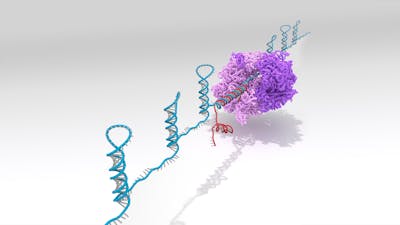The burgeoning field of synthetic biology is designing artificial gene circuits that recognize molecules in their environment and respond by regulating genes with desired activities. In the future, such capabilities could allow the engineering of cells as diagnostic or therapeutic devices, factories for the production of clinically or industrially coveted molecules, and as specialized devices for environmental remediation. Synthetic gene circuits can also be used outside of living cells and fixed to supporting materials such as paper. A current limitation in building highly efficient and reliable synthetic gene circuits, however, is the relative scarcity of compatible high-performance parts that can interpret a complex environment, and reliably control gene expression.
Wyss Institute researchers have engineered a new type of regulator, a “toehold switch”, which enables precise control over the expression of a gene of interest in response to a defined environmental stimulus in diverse synthetic biology applications.
Toehold switches are synthetic RNAs that mimic messenger RNAs whose job it is to shuttle information from the DNA to the protein-synthesizing machinery. They contain a recognition sequence (toehold) for a specific stimulus in form of a specific “input” RNA, and a recognition sequence that the protein-synthesizing machinery (ribosome) needs to bind to initiate the translation of a fused protein-coding sequence into its encoded protein product. In the absence of the “input” RNA, the toehold switch is kept in its OFF state by forming a hairpin structure that uses part of the “input” recognition sequence and the ribosome recognition sequence, which is kept inaccessible. The toehold switch is turned on when a stimulating “input” RNA binds to the toehold and induces the hairpin structure to open up, giving the ribosome access to its recognition sequence to start the synthesis of the encoded protein downstream.

Toehold switches are highly orthogonal and can be deployed in combinations to regulate different steps in a synthetic gene network with high specificity. Alternatively, serializing toehold switch variants in powerful “Ribocomputing Devices” enables the logical computation of complex environments with multiple inductive and prohibitory stimuli and the production of a protein under biologically relevant conditions.
In addition to engineering them into living cells, Wyss Institute researchers are also building toehold switches into synthetic gene circuits that function on different materials such as paper to accurately and sensitively detect pathogens as inexpensive, fast and simple diagnostic tools or produce valuable molecules in low resource settings.
Toehold Switches were licensed to Agile Biodetection under Harvard’s COVID-19 Technology Access Framework to enable the development of new SARS-CoV-2 detection approaches during the coronavirus pandemic. Toehold Switches are available for licensing for additional diagnostic and synthetic biology applications.
